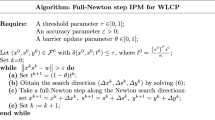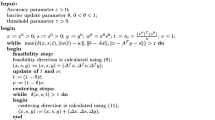Abstract
The Walrasian equilibrium problem is cast as a complementarity problem, and its solution is computed by solving a sequence of linear complementarity problems (SLCP). Earlier numerical experiments have demonstrated the computational efficiency of this approach. So far, however, there exist few relevant theoretical results that characterize the performance of this algorithm.
In the context of a simple example of a Walrasian equilibrium model, we study the iterates of the SLCP algorithm. We show that a particular LCP of this process may have no, one or more complementary solutions. Other LCPs may have both homogeneous and complementary solutions. These features complicate the proof of convergence for the general case.
For this particular example, however, we are able to show that Lemke's algorithm computes a solution to an LCP if one exists,and that the iterative process converges globally.
Similar content being viewed by others
References
R.W. Cottle and G.B. Dantzig, “Complementary pivot theory of mathematical programming,”Linear Algebra and its Applications 1 (1968) 103–125.
B.C. Eaves, “The linear complementarity problem,”Management Science 17 (1971) 612–634.
B.C. Eaves, “A locally quadratically convergent algorithm for computing stationary points,” SOL Technical Report 78-13, Systems Optimization Laboratory, Department of Operations Research, Stanford University, (Stanford, CA, 1978).
N.H. Josephy, “Newton's method for generalized equations,” Technical Report (1965), Mathematics Research Center, University of Wisconsin (Madison, WI, 1979).
T.J. Kehoe, “Multiplicity of equilibria and comparative statics,”The Quarterly Journal of Economics (1985) 119–147.
C.E. Lemke, “Bimatrix equilibrium points and mathematical programming,”Management Science 11 (1965) 681–689.
L. Mathiesen, “Computational experience in solving equilibrium models by a sequence of linear complementarity problems,”Operations Research 33, 6 (1985) 1225–1250.
L. Mathiesen, “Computation of economic equilibria by a sequence of linear complementarity problems,”Mathematical Programming Study 23 (1985) 144–162.
L. Mathiesen and T. Rutherford, “Testing the robustness of an iterative LCP algorithm for solving Walrasian equilibrium models,” Discussion Paper, 0883, Norwegian School of Economics and Business Administration, Bergen, 1983).
J. S. Pang and D. Chan, “Iterative methods for variational and complementarity problems,”Mathematical Programming 24 (1982) 284–313.
P.V. Preckel, “Intertemporal equilibrium models: Development and results,” Ph.D. Dissertation, Department of Operations Research, Stanford University (Standford CA, 1983).
P.V. Preckel,” Alternative algorithms for computing economic equilibria,”Mathematical Programming Study 23 (1985) 163–172.
S.M. Robinson, “Strongly regular generalized equations,”Mathematics of Operations Research 5 (1980) 43–62.
H.E. Scarf, “Some examples of global instability of the competitive equilibrium,”International Economic Review 1 3 (1960) 157–171.
H.E. Scarf with collaboration of T. Hansen,Computation of Economic Equilibria (Yale University Press, New Haven, CT, 1973).
Author information
Authors and Affiliations
Rights and permissions
About this article
Cite this article
Mathiesen, L. An algorithm based on a sequence of linear complementarity problems applied to a walrasian equilibrium model: An example. Mathematical Programming 37, 1–18 (1987). https://doi.org/10.1007/BF02591680
Received:
Revised:
Issue Date:
DOI: https://doi.org/10.1007/BF02591680




